+ Open data
Open data
- Basic information
Basic information
| Entry | Database: PDB / ID: 7c42 | ||||||
|---|---|---|---|---|---|---|---|
| Title | The crystal structure of Trypanosoma brucei RNase D | ||||||
 Components Components | CCHC-type domain-containing protein | ||||||
 Keywords Keywords | HYDROLASE / Trypanosoma brucei / RNase D / guide RNA degradation / RNA BINDING PROTEIN | ||||||
| Function / homology |  Function and homology information Function and homology informationPET complex / piRNA processing / kinetoplast / 3'-5'-RNA exonuclease activity / nucleic acid binding / nucleotide binding / mitochondrion / zinc ion binding Similarity search - Function | ||||||
| Biological species |  | ||||||
| Method |  X-RAY DIFFRACTION / X-RAY DIFFRACTION /  SYNCHROTRON / SYNCHROTRON /  SAD / Resolution: 2 Å SAD / Resolution: 2 Å | ||||||
 Authors Authors | Gao, Y.Q. / Gan, J.H. | ||||||
| Funding support |  China, 1items China, 1items
| ||||||
 Citation Citation |  Journal: Nucleic Acids Res. / Year: 2021 Journal: Nucleic Acids Res. / Year: 2021Title: Structural basis for guide RNA trimming by RNase D ribonuclease in Trypanosoma brucei. Authors: Gao, Y. / Liu, H. / Zhang, C. / Su, S. / Chen, Y. / Chen, X. / Li, Y. / Shao, Z. / Zhang, Y. / Shao, Q. / Li, J. / Huang, Z. / Ma, J. / Gan, J. | ||||||
| History |
|
- Structure visualization
Structure visualization
| Structure viewer | Molecule:  Molmil Molmil Jmol/JSmol Jmol/JSmol |
|---|
- Downloads & links
Downloads & links
- Download
Download
| PDBx/mmCIF format |  7c42.cif.gz 7c42.cif.gz | 80.1 KB | Display |  PDBx/mmCIF format PDBx/mmCIF format |
|---|---|---|---|---|
| PDB format |  pdb7c42.ent.gz pdb7c42.ent.gz | 56.2 KB | Display |  PDB format PDB format |
| PDBx/mmJSON format |  7c42.json.gz 7c42.json.gz | Tree view |  PDBx/mmJSON format PDBx/mmJSON format | |
| Others |  Other downloads Other downloads |
-Validation report
| Summary document |  7c42_validation.pdf.gz 7c42_validation.pdf.gz | 426.3 KB | Display |  wwPDB validaton report wwPDB validaton report |
|---|---|---|---|---|
| Full document |  7c42_full_validation.pdf.gz 7c42_full_validation.pdf.gz | 427.3 KB | Display | |
| Data in XML |  7c42_validation.xml.gz 7c42_validation.xml.gz | 14.7 KB | Display | |
| Data in CIF |  7c42_validation.cif.gz 7c42_validation.cif.gz | 21.6 KB | Display | |
| Arichive directory |  https://data.pdbj.org/pub/pdb/validation_reports/c4/7c42 https://data.pdbj.org/pub/pdb/validation_reports/c4/7c42 ftp://data.pdbj.org/pub/pdb/validation_reports/c4/7c42 ftp://data.pdbj.org/pub/pdb/validation_reports/c4/7c42 | HTTPS FTP |
-Related structure data
- Links
Links
- Assembly
Assembly
| Deposited unit | 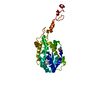
| ||||||||
|---|---|---|---|---|---|---|---|---|---|
| 1 |
| ||||||||
| Unit cell |
|
- Components
Components
| #1: Protein | Mass: 38986.012 Da / Num. of mol.: 1 Source method: isolated from a genetically manipulated source Source: (gene. exp.)  Strain: 927/4 GUTat10.1 / Gene: Tb09.211.3670 / Production host:  | ||||||
|---|---|---|---|---|---|---|---|
| #2: Chemical | | #3: Water | ChemComp-HOH / | Has ligand of interest | N | Has protein modification | Y | |
-Experimental details
-Experiment
| Experiment | Method:  X-RAY DIFFRACTION / Number of used crystals: 1 X-RAY DIFFRACTION / Number of used crystals: 1 |
|---|
- Sample preparation
Sample preparation
| Crystal | Density Matthews: 2.58 Å3/Da / Density % sol: 52.34 % Description: The entry contains friedel pairs in F_plus/minus columns and I_plus/minus columns |
|---|---|
| Crystal grow | Temperature: 291.15 K / Method: vapor diffusion, hanging drop / pH: 5.5 / Details: 0.1 M Bis-Tris pH 5.5, 30% PEG 3350 |
-Data collection
| Diffraction | Mean temperature: 80 K / Serial crystal experiment: N | |||||||||||||||||||||||||||||||||||||||||||||||||||||||||||||||||||||||||||||||||||||||||||||||||||
|---|---|---|---|---|---|---|---|---|---|---|---|---|---|---|---|---|---|---|---|---|---|---|---|---|---|---|---|---|---|---|---|---|---|---|---|---|---|---|---|---|---|---|---|---|---|---|---|---|---|---|---|---|---|---|---|---|---|---|---|---|---|---|---|---|---|---|---|---|---|---|---|---|---|---|---|---|---|---|---|---|---|---|---|---|---|---|---|---|---|---|---|---|---|---|---|---|---|---|---|---|
| Diffraction source | Source:  SYNCHROTRON / Site: SYNCHROTRON / Site:  SSRF SSRF  / Beamline: BL17U / Wavelength: 0.9793 Å / Beamline: BL17U / Wavelength: 0.9793 Å | |||||||||||||||||||||||||||||||||||||||||||||||||||||||||||||||||||||||||||||||||||||||||||||||||||
| Detector | Type: MARMOSAIC 300 mm CCD / Detector: CCD / Date: Apr 30, 2018 | |||||||||||||||||||||||||||||||||||||||||||||||||||||||||||||||||||||||||||||||||||||||||||||||||||
| Radiation | Protocol: SINGLE WAVELENGTH / Monochromatic (M) / Laue (L): M / Scattering type: x-ray | |||||||||||||||||||||||||||||||||||||||||||||||||||||||||||||||||||||||||||||||||||||||||||||||||||
| Radiation wavelength | Wavelength: 0.9793 Å / Relative weight: 1 | |||||||||||||||||||||||||||||||||||||||||||||||||||||||||||||||||||||||||||||||||||||||||||||||||||
| Reflection | Resolution: 1.998→30 Å / Num. obs: 42575 / % possible obs: 98.8 % / Redundancy: 10.2 % / Biso Wilson estimate: 21.93 Å2 / Rmerge(I) obs: 0.116 / Rpim(I) all: 0.036 / Rrim(I) all: 0.121 / Χ2: 0.926 / Net I/σ(I): 9.6 | |||||||||||||||||||||||||||||||||||||||||||||||||||||||||||||||||||||||||||||||||||||||||||||||||||
| Reflection shell | Diffraction-ID: 1
|
- Processing
Processing
| Software |
| ||||||||||||||||||||||||||||||||||||||||||||||||||||||||||||||||||||||||||||||||||||||||||||||||||||||||||||||||||||||||||||||||||||||||||||||||||||||||||||
|---|---|---|---|---|---|---|---|---|---|---|---|---|---|---|---|---|---|---|---|---|---|---|---|---|---|---|---|---|---|---|---|---|---|---|---|---|---|---|---|---|---|---|---|---|---|---|---|---|---|---|---|---|---|---|---|---|---|---|---|---|---|---|---|---|---|---|---|---|---|---|---|---|---|---|---|---|---|---|---|---|---|---|---|---|---|---|---|---|---|---|---|---|---|---|---|---|---|---|---|---|---|---|---|---|---|---|---|---|---|---|---|---|---|---|---|---|---|---|---|---|---|---|---|---|---|---|---|---|---|---|---|---|---|---|---|---|---|---|---|---|---|---|---|---|---|---|---|---|---|---|---|---|---|---|---|---|---|
| Refinement | Method to determine structure:  SAD / Resolution: 2→29.497 Å / SU ML: 0.21 / Cross valid method: THROUGHOUT / σ(F): 1.39 / Phase error: 21.87 / Stereochemistry target values: ML SAD / Resolution: 2→29.497 Å / SU ML: 0.21 / Cross valid method: THROUGHOUT / σ(F): 1.39 / Phase error: 21.87 / Stereochemistry target values: MLDetails: The entry contains friedel pairs in F_plus/minus columns and I_plus/minus columns
| ||||||||||||||||||||||||||||||||||||||||||||||||||||||||||||||||||||||||||||||||||||||||||||||||||||||||||||||||||||||||||||||||||||||||||||||||||||||||||||
| Solvent computation | Shrinkage radii: 0.9 Å / VDW probe radii: 1.11 Å / Solvent model: FLAT BULK SOLVENT MODEL | ||||||||||||||||||||||||||||||||||||||||||||||||||||||||||||||||||||||||||||||||||||||||||||||||||||||||||||||||||||||||||||||||||||||||||||||||||||||||||||
| Displacement parameters | Biso max: 118.61 Å2 / Biso mean: 27.1226 Å2 / Biso min: 9.06 Å2 | ||||||||||||||||||||||||||||||||||||||||||||||||||||||||||||||||||||||||||||||||||||||||||||||||||||||||||||||||||||||||||||||||||||||||||||||||||||||||||||
| Refinement step | Cycle: final / Resolution: 2→29.497 Å
| ||||||||||||||||||||||||||||||||||||||||||||||||||||||||||||||||||||||||||||||||||||||||||||||||||||||||||||||||||||||||||||||||||||||||||||||||||||||||||||
| Refine LS restraints |
| ||||||||||||||||||||||||||||||||||||||||||||||||||||||||||||||||||||||||||||||||||||||||||||||||||||||||||||||||||||||||||||||||||||||||||||||||||||||||||||
| LS refinement shell | Refine-ID: X-RAY DIFFRACTION / Rfactor Rfree error: 0
|
 Movie
Movie Controller
Controller








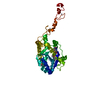
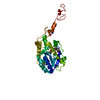
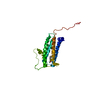

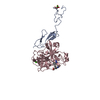
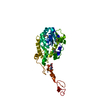


 PDBj
PDBj



